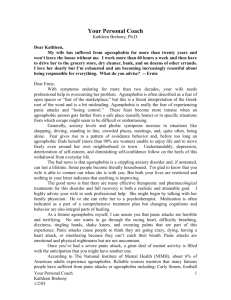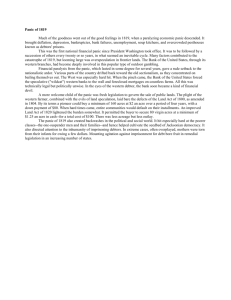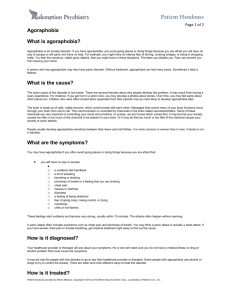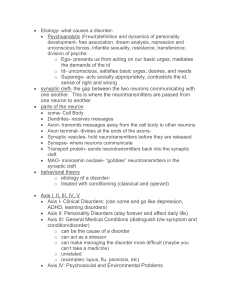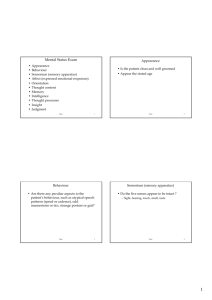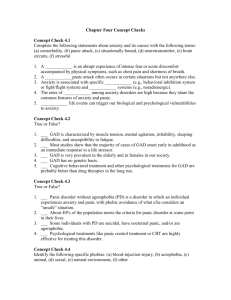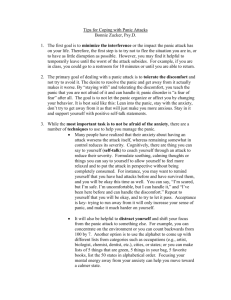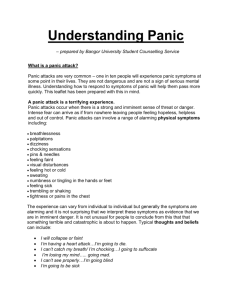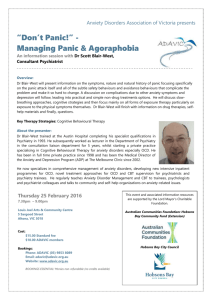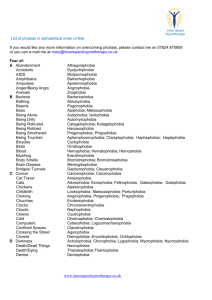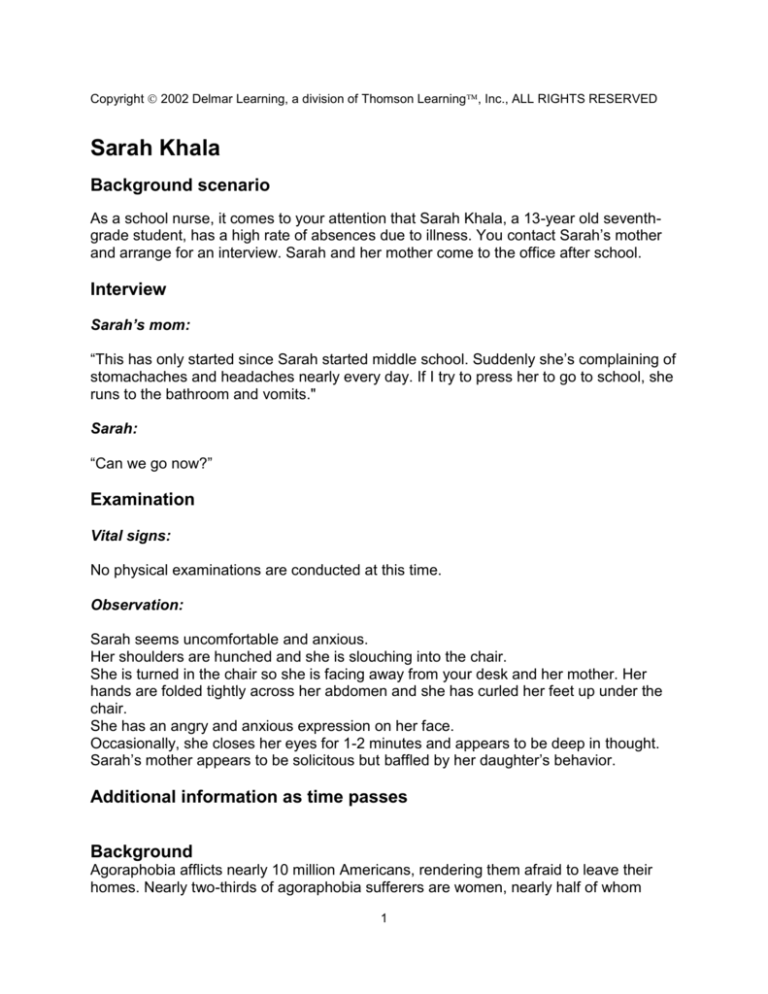
Copyright 2002 Delmar Learning, a division of Thomson Learning, Inc., ALL RIGHTS RESERVED
Sarah Khala
Background scenario
As a school nurse, it comes to your attention that Sarah Khala, a 13-year old seventhgrade student, has a high rate of absences due to illness. You contact Sarah’s mother
and arrange for an interview. Sarah and her mother come to the office after school.
Interview
Sarah’s mom:
“This has only started since Sarah started middle school. Suddenly she’s complaining of
stomachaches and headaches nearly every day. If I try to press her to go to school, she
runs to the bathroom and vomits."
Sarah:
“Can we go now?”
Examination
Vital signs:
No physical examinations are conducted at this time.
Observation:
Sarah seems uncomfortable and anxious.
Her shoulders are hunched and she is slouching into the chair.
She is turned in the chair so she is facing away from your desk and her mother. Her
hands are folded tightly across her abdomen and she has curled her feet up under the
chair.
She has an angry and anxious expression on her face.
Occasionally, she closes her eyes for 1-2 minutes and appears to be deep in thought.
Sarah’s mother appears to be solicitous but baffled by her daughter’s behavior.
Additional information as time passes
Background
Agoraphobia afflicts nearly 10 million Americans, rendering them afraid to leave their
homes. Nearly two-thirds of agoraphobia sufferers are women, nearly half of whom
1
suffered from separation anxiety as children. Often the onset of agoraphobia follows a
traumatic event or stressful period in a person’s life. Agoraphobics avoid public places
such as stores, airplanes, school, or busy streets. By gradually limiting the places they
will go, they often become house bound, afraid to confront even the front yard.
Exposure to feared stimuli causes intense symptoms that are very distressful and can
render the agoraphobic unable to function.
Symptoms and Causes
Agoraphobia is often preceded by panic attacks. A panic attack is a sudden-onset
episode characterized by the feeling that the sufferer is going to die, faint, go crazy, or
suffer some other catastrophic physical event. The physical symptoms of panic attacks
are very real. During a panic attack a sufferer may experience palpitations, chest pain,
shortness of breath, nausea, dizziness, trembling, or faintness. Often the sufferer
believes he or she is dying or has a sense of impending doom. Some panic attack
victims fear that they may react inappropriately and that their own behaviors will be
outside of their control. This terror becomes associated with the sufferer’s surroundings
during the panic attack. This can cause the sufferer to avoid situations associated with
the panic attacks, such as flying, shopping, or driving. More attacks, or the fear of more
attacks, can lead the sufferer to avoid public activities. Symptoms can generalize to
events preceding, following, or similar to the situation that precipitated the original panic
attack. For example, a sufferer experiencing a panic attack on an airplane may start to
avoid airports, loading ramps, or shuttle buses because anticipatory anxiety may
precipitate panic symptoms in those situations. This can cause he or she to gradually
restrict behavior until the sufferer is afraid to leave the house. This condition is known
as agoraphobia.
Agoraphobia is technically defined as a fear of the marketplace. In the modern era, it
means a fear of not being able to escape or control ones behavior in a public situation.
Agoraphobics are afraid of having a panic attack in public and embarrassing themselves
with their behavior. As the safe zone becomes smaller for the agoraphobic, the quality
of life diminishes. Agoraphobia may be accompanied by other disorders such as
depression, suicide, health problems, addictions, or a dependent personality.
Treatment
Many of those who suffer from panic attacks and agoraphobia do not seek medical help
for fear of embarrassment or the trauma of the actual doctor visit may seem
overwhelming. While researchers do not yet fully understand the cause of panic attacks
and agoraphobia, they do agree that prompt treatment is the most effective means of
returning a sufferer to a normal lifestyle. The two primary treatment approaches are
medication and cognitive-behavioral psychotherapy. Currently, the most effective
medications for this disorder are those in the selective serotonin reuptake inhibitor
(SSRI) family. Of the SSRIs, Paxil and Zoloft have been approved by the U.S. Food and
Drug Administration (FDA) for treating panic disorder. All SSRIs have been shown to be
effective for treating this problem. In the past, other antidepressants have been used to
treat panic disorder with varying results. Another frequently prescribed medication is
2
Xanax, which is used to treat the acute panic symptoms. For full benefit, medication
dosages should be closely monitored, and abrupt discontinuation of treatment should be
avoided.
Cognitive-behavioral therapy works on a desensitization principle. By teaching the client
relaxation techniques and then gradually reintroducing the client to situations that
inspire panic, the client learns to cope with those experiences calmly. Medication alone
has a higher relapse rate than cognitive therapy; however,
Additional information
Agoraphobia secondary to the stress of divorce and a new school environment.
List your findings and conclusions:
You refer Sarah to the school psychologist. After further examination and testing, Sarah
is diagnosed with agoraphobia. She begins regular counseling and is prescribed Zoloft.
Nursing diagnoses:
00127
00125
00153
00052
00146
00070
00053
00069
Impaired environmental interpretation syndrome
Powerlessness
Risk for situational low self-esteem
Impaired social interaction
Anxiety
Impaired adjustment
Social isolation
Ineffective coping
Laboratory and Test Data:
No laboratory testing was performed
Quiz
1. A client is diagnosed with panic attacks and agoraphobia. What is an appropriate
nursing diagnosis for this case?
a. Agoraphobia
b. Impaired social interaction
c. Social phobia
d. Inappropriate anxiety
2. The nurse is interviewing a client diagnosed with agoraphobia. What information
might contribute to understanding the client’s diagnosis?
3
a. Does she have a history of schizophrenia?
b. Is she diabetic?
c. Has she recently experienced a traumatic event or stressful period in her life?
d. Does she do strenuous physical activity more than three times a week?
3. A client diagnosed with agoraphobia reports to the nurse about situations that she
commonly avoids. Of the following, which situation would the nurse expect the client to
avoid?
a. Staying at home
b. Small examining rooms
c. Crowds
d. None of the above
4. A client who reports being anxious is assessed after he experiences what may be a
panic attack. What set of symptoms are most likely to be associated with a panic
attack?
a. Palpitations, nausea, sense of impending doom
b. Sweating, headache, eye pain
c. Anxiety, memory loss, confusion
d. Nausea, vomiting, diarrhea
5. While a nurse is assessing a client who suffers panic attacks, the client discusses her
method of coping. What is one method of coping that is not considered being effective
for long-term resolution of panic attacks?
a. Actively seeking out the situations in which panic attacks occur
b. Avoiding the situations in which panic attacks occur
c. Using relaxation exercises to help her cope with panic attacks
d. Taking prescription sedatives
6. A client is newly diagnosed with agoraphobia. What is the technical definition of
agoraphobia?
a. Fear of open spaces
b. Fear of crowds
c. Fear of the marketplace
d. Fear of heights
7. A client who has agoraphobia might also have which other disorders?
a. High blood pressure and low blood sugar
b. Anxiety and high blood pressure
c. Addictions and depression
d. None of the above
8. A client asks for treatment for newly diagnosed agoraphobia. The nurse is asked to
provide treatment. What is a common treatment?
a. Cognitive-behavioral psychotherapy
4
b. Shock therapy
c. Analytical psychotherapy
d. Regression therapy
9. A client’s doctor prescribes medication for the treatment of panic. The FDA has
approved what medication for the treatment of a panic disorder?
a. Prozac
b. Paxil
c. Aspirin
d. Ritalin
10. The nurse is treating a client for agoraphobia using cognitive-behavioral therapy.
What principle does cognitive-behavioral therapy employ?
a. Exploring possible childhood traumas
b. Immersing the client in the feared situation
c. Understanding the absurdity of one’s fears
d. Gradual desensitization regarding the feared situation
Copyright 2002 Delmar Learning, a division of Thomson Learning, Inc., ALL RIGHTS RESERVED
5

